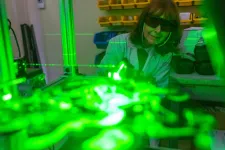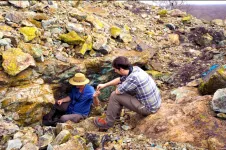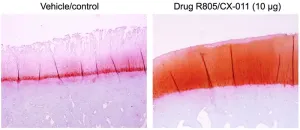(Press-News.org) Scientists have gained new insights into the part of the brain that gives us a sense of direction, by tracking neural activity with the latest advances in brain imaging techniques. The findings shed light on how the brain orients itself in changing environments – and even the processes that can go wrong with degenerative diseases like dementia, that leave people feeling lost and confused.
“Neuroscience research has witnessed a technology revolution in the last decade allowing us to ask and answer questions that could only be dreamed of just years ago,” says Mark Brandon, an Associate Professor of psychiatry at McGill University and researcher at the Douglas Research Centre, who co-led the research with Zaki Ajabi, a former student at McGill University and now a postdoctoral research fellow at Harvard University.
Reading the brain's internal compass
To understand how visual information impacts the brain’s internal compass, the researchers exposed mice to a disorienting virtual world while recording the brain's neural activity. The team recorded the brain’s internal compass with unprecedented precision using the latest advances in neuronal recording technology.
This ability to accurately decode the animal's internal head direction allowed the researchers to explore how the Head-Direction cells, which make up the brain’s internal compass, support the brain’s ability to re-orient itself in changing surroundings. Specifically, the research team identified a phenomenon they term ‘network gain’ that allowed the brain’s internal compass to reorient after the mice were disoriented. “It’s as if the brain has a mechanism to implement a ‘reset button’ allowing for rapid reorientation of its internal compass in confusing situations,” says Ajabi.
Although the animals in this study were exposed to unnatural visual experiences, the authors argue that such scenarios are already relevant to the modern human experience, especially with the rapid spread of virtual reality technology. These findings “may eventually explain how virtual reality systems can easily take control over our sense of orientation,” adds Ajabi.
The results inspired the research team to develop new models to better understand the underlying mechanisms. “This work is a beautiful example of how experimental and computational approaches together can advance our understanding of brain activity that drives behaviour,” says co-author Xue-Xin Wei, a computational neuroscientist and an Assistant Professor at The University of Texas at Austin.
Degenerative diseases
The findings also have significant implications for Alzheimer's disease. “One of the first self-reported cognitive symptoms of Alzheimer’s is that people become disoriented and lost, even in familiar settings,” says Brandon. The researchers expect that a better understanding of how the brain's internal compass and navigation system works will lead to earlier detection and better assessment of treatments for Alzheimer’s disease.
About the study
"Population dynamics of head-direction neurons during drift and reorientation" by Zaki Ajabi, Alexandra Keinath, Xue-Xin Wei, and Mark Brandon was published in Nature. The research was supported by the Natural Sciences and Engineering Research Council of Canada and the Canadian Institutes of Health Research.
END
How the brain's 'internal compass' works
New study reveals how the brain makes sense of changing environmental cues
2023-03-22
ELSE PRESS RELEASES FROM THIS DATE:
Patricia M. LoRusso, DO, Ph.D. (hc), elected as American Association for Cancer Research President-Elect for 2023-2024
2023-03-22
PHILADELPHIA – The members of the American Association for Cancer Research (AACR) have elected Patricia M. LoRusso, DO, PhD (hc), as the AACR President-Elect for 2023-2024. LoRusso will become President-Elect on Monday, April 17, during the AACR’s Annual Business Meeting of Members at the AACR Annual Meeting 2023 in Orlando, Florida. She will assume the Presidency in April 2024 at the AACR Annual Meeting in San Diego, California.
LoRusso is a professor of medicine (medical oncology); chief of experimental therapeutics; associate cancer center director for experimental therapeutics; and leader of the Phase I disease aligned research ...
Is bone health linked to brain health?
2023-03-22
EMBARGOED FOR RELEASE UNTIL 4 P.M. ET, WEDNESDAY, MARCH 22, 2023
MINNEAPOLIS – People who have low bone density may have an increased risk of developing dementia compared to people who have higher bone density, according to a study published in the March 22, 2023, online issue of Neurology®, the medical journal of the American Academy of Neurology. The study does not prove that low bone density causes dementia. It only shows an association.
“Low bone density and dementia are two conditions that commonly affect older people simultaneously, especially as bone loss often increases due to physical inactivity and poor ...
In epilepsy, higher risk of early death varies based on severity, other factors
2023-03-22
EMBARGOED FOR RELEASE UNTIL 4 P.M. ET, WEDNESDAY, MARCH 22, 2023
MINNEAPOLIS – A new study has found that people with epilepsy have an increased risk of early death and the increased risk varies depending on where they live, the number of medications they take and what other diseases they may have. The study is published in the March 22, 2023, online issue of Neurology®, the medical journal of the American Academy of Neurology.
“Our research found an increased risk even among those who do not have ...
Air flow research could reduce disease, contamination spread
2023-03-22
Air flow in a room can impact the transmission of viruses like COVID-19.
A Texas A&M AgriLife Research scientist is studying how heating, ventilation and air conditioning, HVAC, system configurations and building designs could mitigate the spread of microorganisms, including viruses, that are detrimental to human health.
Maria King, Ph.D., director of the Center for Agricultural Air Quality Engineering and Science in the Department of Biological and Agricultural Engineering, recently received a $400,000, two-year National ...
Memory B cell marker predicts long-lived antibody response to flu vaccine
2023-03-22
BIRMINGHAM, Ala. – Memory B cells play a critical role to provide long-term immunity after a vaccination or infection. In a study published in the journal Immunity, researchers describe a distinct and novel subset of memory B cells that predict long-lived antibody responses to influenza vaccination in humans.
These effector memory B cells appear to be poised for a rapid serum antibody response upon secondary challenge one year later, Anoma Nellore, M.D., Fran Lund, Ph.D., and colleagues at the University of Alabama at Birmingham and Emory University report. Evidence from transcriptional and epigenetic profiling shows that the cells in this subset differ from ...
Copper artifacts unearth new cultural connections in southern Africa
2023-03-22
COLUMBIA, Mo. – Chemical and isotopic analysis of copper artifacts from southern Africa reveals new cultural connections among people living in the region between the 5th and 20th centuries according to a University of Missouri researcher and colleagues.
People in the area between northern South Africa and the Copperbelt region in central Africa were more connected to one another than scholars previously thought, said Jay Stephens, a post-doctoral fellow in the MU Research Reactor (MURR) Archaeometry Lab.
“Over the past 20 to 30 years, most archaeologists ...
Babies or beauty?
2023-03-22
Have you ever marveled at the vast diversity of life on our planet, from tiny creatures living only a few hours to majestic beings that can survive for centuries? These differences in lifespan, size, and reproductive age are known as life-history strategies, and they have evolved over time as organisms adapt to their environments.
Evolutionary biologists have long been interested in understanding the factors that contribute to the evolution and maintenance of multiple alternative life-history strategies (ALHS) within species that lead to adaptation and novel traits. A new study published in Science Advances has not only revealed that an ALHS in Colias ...
The Protein Society announces its 2023 award winners
2023-03-22
FOR IMMEDIATE RELEASE
March 22, 2023
THE PROTEIN SOCIETY ANNOUNCES ITS 2023 AWARD RECIPIENTS
LOS ANGELES, CA – The Protein Society, the premier international society dedicated to supporting protein research, announces the winners of the 2023 Protein Society Awards, which will be conferred at the 37th Anniversary Symposium, July 13 – 16, 2023, in Boston, Massachusetts. Plenary talks from select award recipients will take place throughout the 3.5-day event. The scientific accomplishments of the awardees, highlighted here as described by their nominators, demonstrate their lasting impact on protein science.
The Carl Brändén Award, sponsored by Rigaku ...
Road noise makes your blood pressure rise – literally
2023-03-22
If you live near a busy road you might feel like the constant sound of roaring engines, honking horns and wailing sirens makes your blood pressure rise. Now a new study published today in JACC: Advances confirms it can do exactly that.
Previous studies have shown a connection between noisy road traffic and increased risk of hypertension. However, strong evidence was lacking, and it was unclear whether noise or air pollution played a bigger role. The new research shows that it is exposure to road traffic noise itself that can elevate hypertension risk.
“We were a ...
Potential relief for osteoarthritis moves to clinical trial after animal studies
2023-03-22
A team of researchers at the Keck School of Medicine of USC have found a drug with the potential for curbing painful hyperinflammation from osteoarthritis, according to results of an animal study.
The findings, published March 22nd in Science Translational Medicine, indicate that a drug compound, R805/CX-011, may modulate an important cell receptor in the body’s immune system, GP130, that signals when antibodies should attack a virus or infection. The animal model studies showed that the drug compound can disrupt the receptor’s over-activation of inflammation, and still manage pain ...
LAST 30 PRESS RELEASES:
NTIDE: Disability employment holds steady after data hiatus
Social lives of viruses affect antiviral resistance
Dose of psilocybin, dash of rabies point to treatment for depression
Helping health care providers navigate social, political, and legal barriers to patient care
Barrow Neurological Institute, University of Calgary study urges “major change” to migraine treatment in Emergency Departments
Using smartphones to improve disaster search and rescue
Robust new photocatalyst paves the way for cleaner hydrogen peroxide production and greener chemical manufacturing
Ultrafast material captures toxic PFAS at record speed and capacity
Plant phenolic acids supercharge old antibiotics against multidrug resistant E. coli
UNC-Chapel Hill study shows AI can dramatically speed up digitizing natural history collections
OYE Therapeutics closes $5M convertible note round, advancing toward clinical development
Membrane ‘neighborhood’ helps transporter protein regulate cell signaling
Naval aviator turned NPS doctoral student earns national recognition for applied quantum research
Astronomers watch stars explode in real time through new images
Carbon-negative building material developed at Worcester Polytechnic Institute published in matter
Free radicals caught in the act with slow spectroscopy
New research highlights Syntax Bio’s platform for simple yet powerful programming of human stem cells
Researchers from the HSE University investigated reading in adolescents
Penn Nursing study: Virtual nursing programs in hospitals fall short of expectations
Although public overwhelmingly supports hepatitis B vaccine for a newborn, partisan differences exist
DFW backs UTA research to bolster flood resilience
AI brain scan model identifies stroke, brain tumors and aneurysms – helping radiologists triage and speed up diagnoses
U.S. News & World Report gives Hebrew Rehabilitation Center highest rating
Optica and DPG name Antoine Browaeys 2026 Herbert Walther Award recipient
The presence of a gun in the home increases the risk of suicide by three to five times
PFAS exposure and endocrine disruption among women
Vaccines and the 2024 US presidential election
New approach narrows uncertainty in future warming and remaining carbon budget for 2 °C
When pregnancy emergencies collide with state abortion bans
American College of Cardiology supports front of package nutrition labeling
[Press-News.org] How the brain's 'internal compass' worksNew study reveals how the brain makes sense of changing environmental cues




